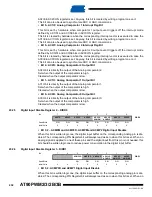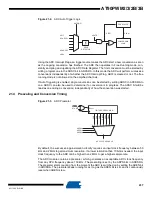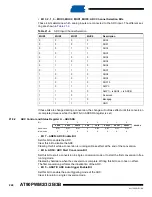
240
4317I–AVR–01/08
AT90PWM2/3/2B/3B
If Auto Triggering is used, the exact time of the triggering event can be indeterministic. Special
care must be taken when updating the ADMUX Register, in order to control which conversion
will be affected by the new settings.
If both ADATE and ADEN is written to one, an interrupt event can occur at any time. If the
ADMUX Register is changed in this period, the user cannot tell if the next conversion is based
on the old or the new settings. ADMUX can be safely updated in the following ways:
1.
When ADATE or ADEN is cleared.
2.
During conversion, minimum one ADC clock cycle after the trigger event.
3.
After a conversion, before the interrupt flag used as trigger source is cleared.
When updating ADMUX in one of these conditions, the new settings will affect the next ADC
conversion.
In order to start a conversion on an amplified channel, there is a dedicated ADASCR bit in ADC-
SRB register which wait for the next amplifier trigger event before really starting the conversion
by an hardware setting of the ADSC bit in ADCSRA register.
21.5.1
ADC Input Channels
When changing channel selections, the user should observe the following guidelines to ensure
that the correct channel is selected:
•
In Single Conversion mode, always select the channel before starting the conversion. The
channel selection may be changed one ADC clock cycle after writing one to ADSC.
However, the simplest method is to wait for the conversion to complete before changing the
channel selection.
•
In Free Running mode, always select the channel before starting the first conversion. The
channel selection may be changed one ADC clock cycle after writing one to ADSC.
However, the simplest method is to wait for the first conversion to complete, and then
change the channel selection. Since the next conversion has already started automatically,
the next result will reflect the previous channel selection. Subsequent conversions will
reflect the new channel selection.
•
In Free Running mode, because the amplifier clear the ADSC bit at the end of an amplified
conversion, it is not possible to use the free running mode, unless ADSC bit is set again by
soft at the end of each conversion.
21.5.2
ADC Voltage Reference
The reference voltage for the ADC (V
REF
) indicates the conversion range for the ADC. Single
ended channels that exceed V
REF
will result in codes close to 0x3FF. V
REF
can be selected as
either AV
CC
, internal 2.56V reference, or external AREF pin.
AV
CC
is connected to the ADC through a passive switch. The internal 2.56V reference is gener-
ated from the internal bandgap reference (V
BG
) through an internal amplifier. In either case, the
external AREF pin is directly connected to the ADC, and the reference voltage can be made
more immune to noise by connecting a capacitor between the AREF pin and ground. V
REF
can
also be measured at the AREF pin with a high impedant voltmeter. Note that V
REF
is a high
impedant source, and only a capacitive load should be connected in a system.
If the user has a fixed voltage source connected to the AREF pin, the user may not use the other
reference voltage options in the application, as they will be shorted to the external voltage. If no
external voltage is applied to the AREF pin, the user may switch between AV
CC
and 2.56V as
reference selection. The first ADC conversion result after switching reference voltage source
may be inaccurate, and the user is advised to discard this result.
Содержание AT90PWM2
Страница 344: ...346 4317I AVR 01 08 AT90PWM2 3 2B 3B 31 1 SO24...
Страница 345: ...347 4317I AVR 01 08 AT90PWM2 3 2B 3B 31 2 SO32...
Страница 346: ...348 4317I AVR 01 08 AT90PWM2 3 2B 3B 31 3 QFN32...
Страница 347: ...349 4317I AVR 01 08 AT90PWM2 3 2B 3B...
















































